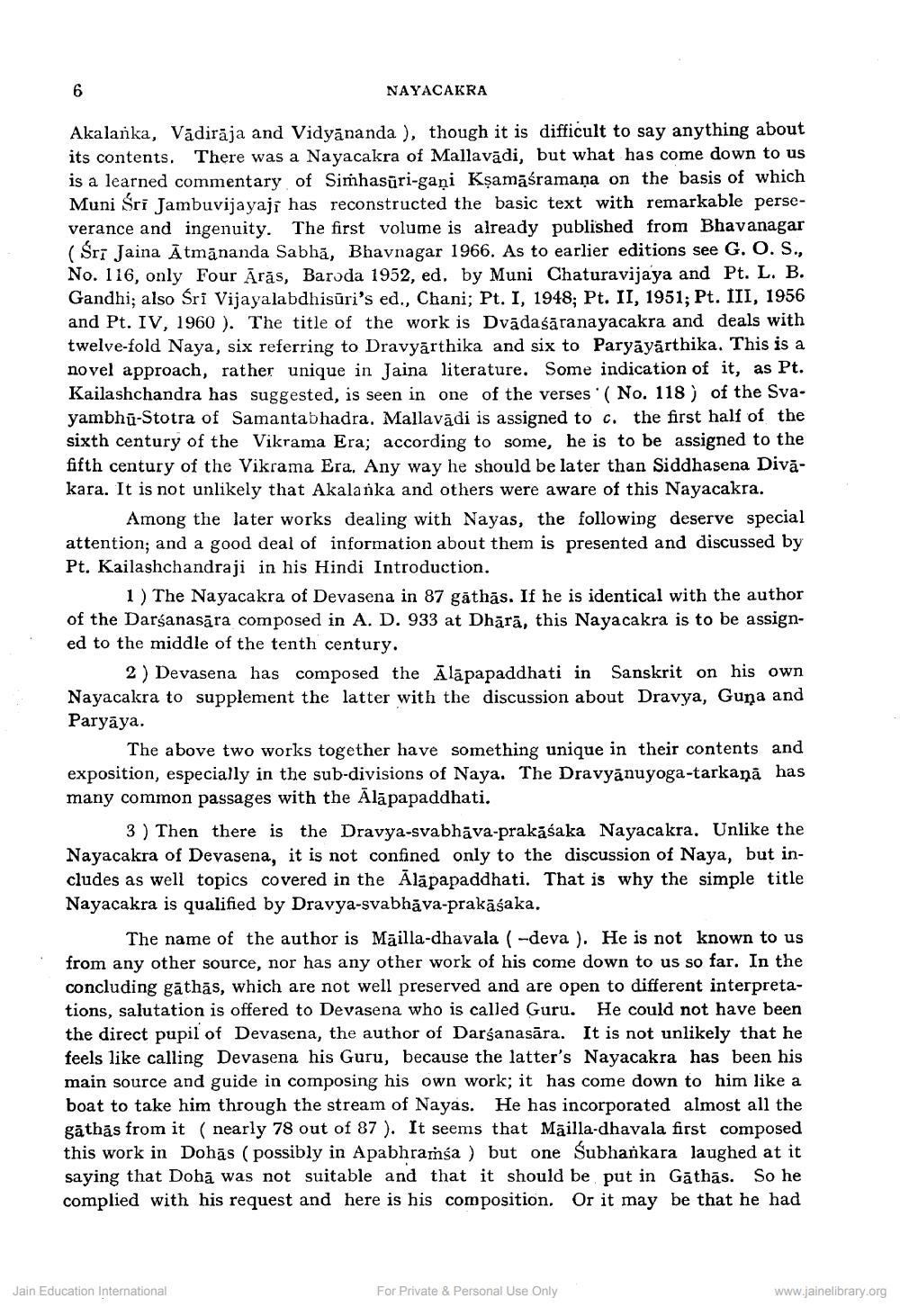Book Title: Naychakko Author(s): Mailldhaval, Kailashchandra Shastri Publisher: Bharatiya Gyanpith View full book textPage 8
________________ NAYACAKRA Akalanka, Vädirāja and Vidyānanda ), though it is difficult to say anything about its contents. There was a Nayacakra of Mallavādi, but what has come down to us is a learned commentary of Simhasūri-gaại Kşamāśramaņa on the basis of which Muni Sri Jambuvijayaji has reconstructed the basic text with remarkable perseverance and ingenuity. The first volume is already published from Bhavanagar (Sri Jaina Ātmānanda Sabha, Bhavnagar 1966. As to earlier editions see G. O. S., No. 116, only Four Ārās, Baroda 1952, ed. by Muni Chaturavijaya and Pt. L. B. Gandhi; also Sri Vijayalabdhisūri's ed., Chani; Pt. I, 1948; Pt. II, 1951; Pt. III, 1956 and Pt. IV, 1960). The title of the work is Dvādaśāranayacakra and deals with twelve-fold Naya, six referring to Dravyārthika and six to Paryāyārthika. This is a novel approach, rather unique in Jaina literature. Some indication of it, as Pt. Kailashchandra has suggested, is seen in one of the verses (No. 118 ) of the Svayambhū-Stotra of Samantabhadra. Mallavādi is assigned to c. the first half of the sixth century of the Vikrama Era; according to some, he is to be assigned to the fifth century of the Vikrama Era. Any way he should be later than Siddhasena Divakara. It is not unlikely that Akalanka and others were aware of this Nayacakra. Among the later works dealing with Nayas, the following deserve special attention; and a good deal of information about them is presented and discussed by Pt. Kailashchandraji in his Hindi Introduction. 1) The Nayacakra of Devasena in 87 gāthās. If he is identical with the author of the Darsanasāra composed in A. D. 933 at Dhārā, this Naya cakra is to be assigned to the middle of the tenth century. 2 ) Devasena has composed the Alāpapaddhati in Sanskrit on his own Nayacakra to supplement the latter with the discussion about Dravya, Guņa and Paryāya. The above two works together have something unique in their contents and exposition, especially in the sub-divisions of Naya. The Dravyānuyoga-tarkaņā has many common passages with the Alāpapaddhati. 3) Then there is the Dravya-svabhāva-prakāśaka Nayacakra. Unlike the Nayacakra of Devasena, it is not confined only to the discussion of Naya, but includes as well topics covered in the Alāpapaddhati. That is why the simple title Nayacakra is qualified by Dravya-svabhāva-prakāśaka. The name of the author is Māilla-dhavala (-deva ). He is not known to us from any other source, nor has any other work of his come down to us so far. In the concluding gāthās, which are not well preserved and are open to different interpretations, salutation is offered to Devasena who is called Guru. He could not have been the direct pupil of Devasena, the author of Darsanasāra. It is not unlikely that he feels like calling Devasena his Guru, because the latter's Nayacakra has been his main source and guide in composing his own work; it has come down to him like a boat to take him through the stream of Nayas. He has incorporated almost all the gāthas from it (nearly 78 out of 87). It seems that Mailla-dhavala first composed this work in Dohās (possibly in Apabhramsa ) but one Subhankara laughed at it saying that Dohā was not suitable and that it should be put in Gāthās. So he complied with his request and here is his composition. Or it may be that he had Jain Education International For Private & Personal Use Only www.jainelibrary.orgPage Navigation
1 ... 6 7 8 9 10 11 12 13 14 15 16 17 18 19 20 21 22 23 24 25 26 27 28 29 30 31 32 33 34 35 36 37 38 39 40 41 42 43 44 45 46 47 48 49 50 51 52 53 54 55 56 57 58 59 60 61 62 63 64 65 66 67 68 69 70 71 72 73 74 75 76 77 78 79 80 81 82 ... 328
